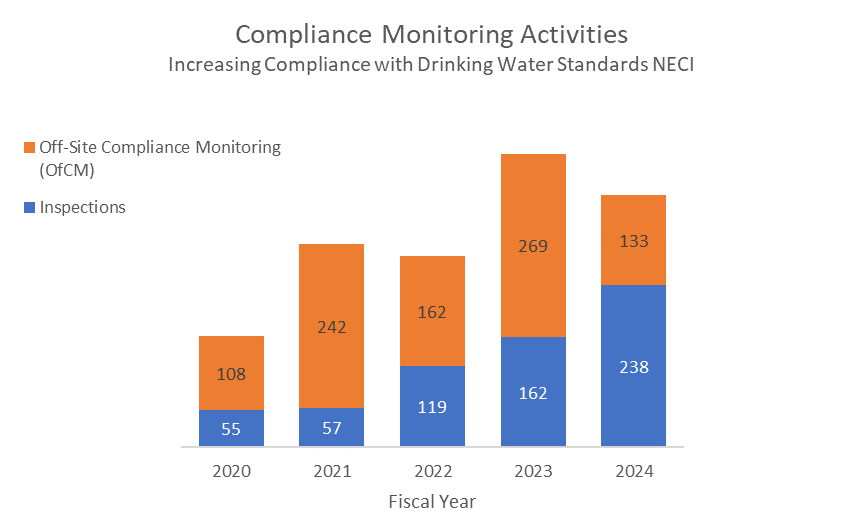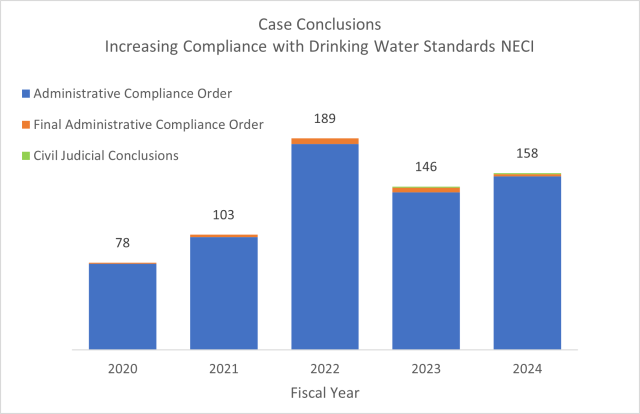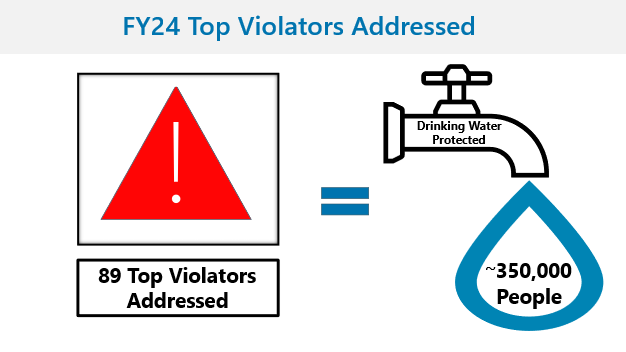National Enforcement and Compliance Initiative: Increasing Compliance with Drinking Water Standards
Problem

In the United States, about 90 percent of the population gets drinking water from approximately 50,000 regulated public water systems that provide water year-round, referred to as Community Water Systems or CWSs. Safe Drinking Water Act violations at CWS expose millions of people to health risks each year. For example, in fiscal year (FY) 2022, over 18,000 CWSs had a least one Safe Drinking Water Act violation, and almost 3,000 CWSs had a health-based violation, resulting in 22 million Americans consuming water with at least one health- based violation of drinking water standards.
Since FY 2020, EPA has included safe drinking water as a National Enforcement Compliance Initiative or NECI. While EPA, working with the states, Tribes, and territories, has made considerable progress in improving Safe Drinking Water Act compliance, further improvement in compliance is needed. Because of ongoing noncompliance and continued health risks, EPA is continuing this initiative for the FY 2024-2027 NECI cycle.
Goals
Under the Increasing Compliance with Drinking Water Standards NECI, EPA continues to pursue two fundamental goals to protect public health.
* Primacy agencies are state tribal or territory agencies with primary authority to enforce drinking water regulations. EPA will support shared accountability for inspections and enforcement with primacy agencies by developing and enhancing EPA and primacy agency inspector skills, expertise, and capacity to monitor and enforce the SDWA.
FY 2024 Results
In FY 2024, EPA used inspections, enforcement, and technical assistance to improve drinking water quality across the country. The following examples of NECI activities illustrate EPA’s efforts to improve drinking water quality at CWSs.
Cyber Security
Safe Drinking Water Act Section 1433 requires CWSs serving greater than 3,300 people to evaluate potential risks to their system, including from cybersecurity, climate change, and natural disasters. In FY 2024 EPA Office of Enforcement and Compliance Assurance partnered with EPA Office of Water, Cybersecurity and Infrastructure Security Agency, Federal Bureau of Investigation, and the National Security Agency as part of a whole of government approach aimed at strengthening public utility resiliency to mounting cyber-attacks. In May 2024, EPA issued an enforcement alert titled “EPA Increases Enforcement Activities to Ensure Drinking Water Systems Address Cybersecurity Threats.” The alert emphasizes that EPA is focusing on cybersecurity as it conducts more targeted inspections and enforcement nationally and showcases the federal tools available for systems to immediately improve their resiliency.
Inspections, Off-Site Compliance Monitoring, and Enforcement Actions
EPA’s strategy for improving Safe Drinking Water Act compliance is focused on building EPA’s field presence by performing inspections, reviewing compliance records for CWSs and collaborating with primacy agencies to support their compliance and enforcement activities.
In FY 2024, EPA led 238 CWS inspections in coordination with primacy agencies and performed 133 offsite compliance monitoring activities at CWSs. Offsite compliance monitoring activities included inspectors’ review of records and monitoring reports, and remote interviews conducted without entering the facility.
In addition, 206 of EPA’s onsite inspections included an evaluation of the system’s compliance with Safe Drinking Water Act section 1433 risk evaluation requirements.

Enforcement Cases
Under the Safe Drinking Water Act, EPA has administrative and judicial enforcement authority to ensure CWSs address regulatory noncompliance and emergencies. If the agency has information about a risk that may present an imminent and substantial endangerment to public health, and appropriate state and local authorities have not acted, the agency may take action under its Safe Drinking Water Act emergency powers.
In FY 2024, EPA completed 158 Safe Drinking Water Act enforcement actions at 144 CWSs, protecting public health and drinking water for over 1.5 million people. Eight of these enforcement actions were taken in communities overburdened by pollution and with potential environmental justice concerns to address time-critical health threats. Enforcement highlights include:
Westchester Joint Water Works in New York: In September 2024, a U.S. District Court entered a consent decree between the United States, the State of New York, and Westchester Joint Water Works or WJWW, the CWS serving Westchester County, New York, to resolve longstanding Safe Drinking Water Act violations. Among other things, WJWW violated the Surface Water Treatment Rules, which are meant to reduce illnesses caused by pathogens such as Legionella, Giardia lamblia, and Cryptosporidium. The settlement requires WJWW to construct a $138 million filtration plant, which is expected to be fully operational by 2029. Approximately 120,000 people in Westchester County will benefit from the improved filtration.
Westerly Water Department: In April 2024, EPA issued an administrative order to the Westerly Water Department in Rhode Island for its failure to certify completion of its Emergency Response Plan, as required by Safe Drinking Water Act Section 1433. The order required the Water Department to comply within 30 days. The Water Department’s service area includes communities overburdened by pollution with potential environmental justice concerns.
CJT Group, LLC Mobile Home Parks in Americus, Georgia: In August 2024, EPA issued an emergency administrative order for six CWSs in Georgia owned and operated by CJT Group LLC for Safe Drinking Water Act violations. The settlement addresses the ongoing inadequacy of disinfectant levels in the drinking water supplied to customers. Collectively, the six CWSs serve approximately 500 residents. The emergency order requires CJT Group LLC to issue public notice to customers, address maintenance issues, perform daily monitoring of the disinfectant process, and provide alternative water to customers if the disinfectant residual falls below the required level or if the pressure in the distribution system falls.
Nooksack Tribe: In June 2024, EPA finalized six administrative orders on consent with the Nooksack Indian Tribe for violations at multiple water systems that collectively serve approximately 1,300 people on the Nooksack Reservation in Deming, Washington. These orders establish schedules to correct National Primary Drinking Water Regulations violations, including failure to monitor for acute contaminants like nitrate and failure to provide required public notice about the systems’ violations to residents served.

Addressing Noncompliance by Top Violators

EPA reduced the number of CWSs in longstanding noncompliance by addressing 89 (25.6%) of the 357 systems identified as “top violators.” Top violators are drinking water systems that have difficulty resolving their compliance issues or that have a formal enforcement action concerning long-unresolved health-based violations. The top violator designation will ensure that EPA prioritizes compliance problems with the greatest impact on public health and resolves those issues in a timely manner. Where top violator systems have not yet returned compliance, EPA and primacy agencies have taken actions to ensure these systems can achieve compliance, either through technical assistance, further enforcement, and/or other appropriate actions.
Improved System Performance with Compliance Advisors

In FY 2020, EPA launched the Compliance Advisors for Sustainable Water Systems program to provide effective on-the-ground technical assistance to help CWSs achieve and sustain environmental compliance. In FY 2024, EPA assisted 128 systems in, including 25 Tribal systems, through this program. Approximately, 72 percent of these systems are in communities that are overburdened and under-resourced with potential environmental justice concerns. Assistance includes recommendations to improve system compliance, development of system operation protocols, resource evaluations, and operator training.
Inspector Capacity and Technical Expertise
To increase inspector capacity and technical expertise EPA provides multiple training programs. In FY 2024, EPA hosted the following trainings:
- Safe Drinking Water Act Inspector Training – first advanced, in-person training for 70 EPA and state inspectors.
- Public Water System Supervision Inspector Fundamentals Training: provided to support credentialing of EPA and state inspectors, with 312 participants completing the four-day training.,
- Two virtual programs: 1) cybersecurity inspection training for 129 EPA participants and 2) cybersecurity table-top exercises for 91 EPA inspectors.
- On-the-job trainings: provided at 10 CWSs to more than 20 inspectors.
